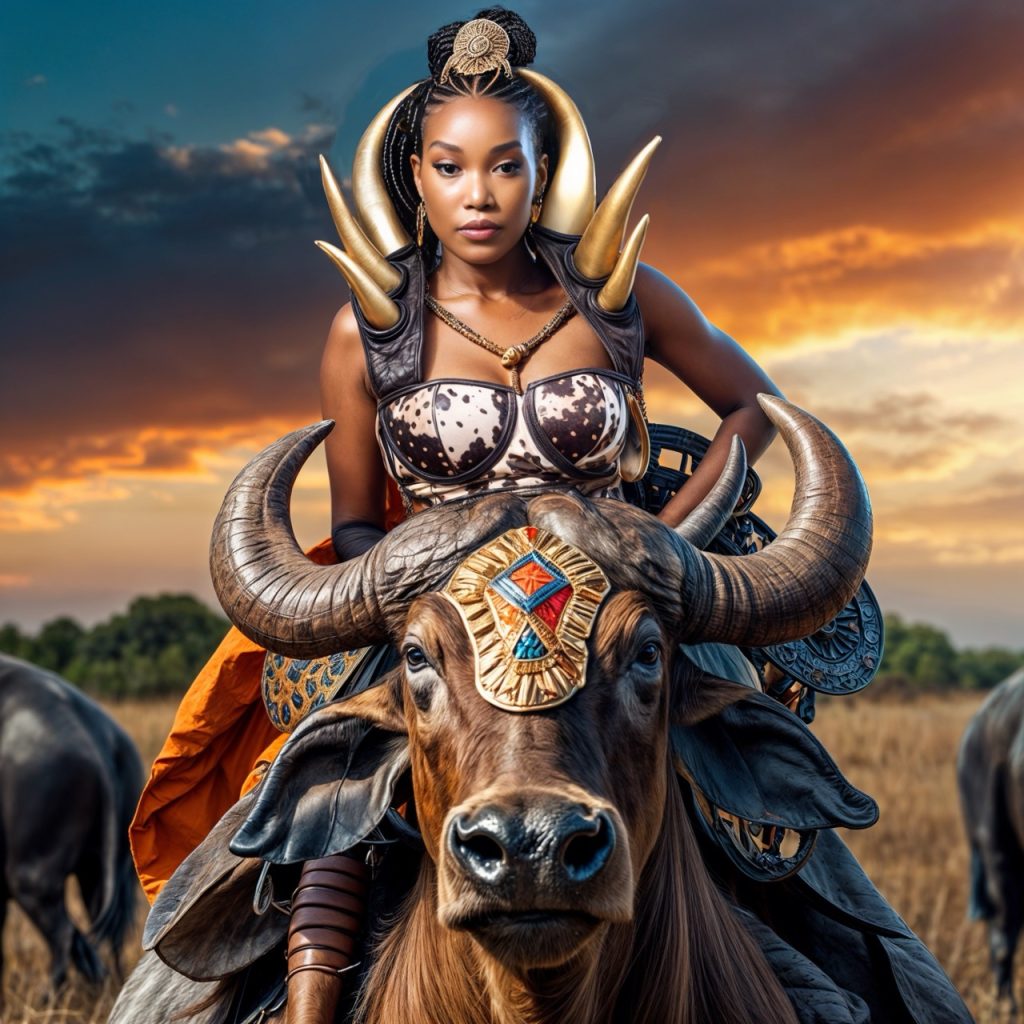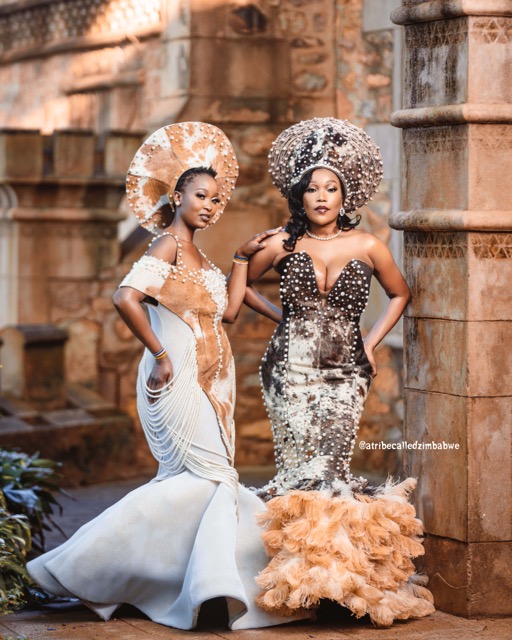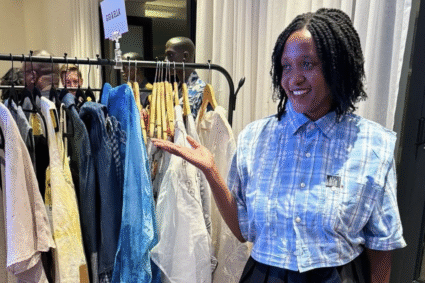
This week, our Sunday Luminary spotlight is on Nomakhosazana Khanyile Ncube, widely known as Zana ’Kay (ZK), a name filled with cultural pride and innovation. As the Founder and Creative Director of A Tribe Called Zimbabwe, Zana ‘Kay channels her passion for Zimbabwe’s heritage into designs that celebrate the nation’s rich history, identity, and resilience.
A visionary inspired by the architectural legacy of Great Zimbabwe and the enduring role of cattle in Zimbabwean culture, Zana ‘Kay redefines fashion as a bridge between tradition and modernity. Her brand creates one-of-a-kind pieces from locally sourced Nguni cowhide, blending authenticity with contemporary elegance to celebrate the vibrant spirit of Zimbabwe.
In this exclusive interview, she shares her journey of elevating Zimbabwean culture on the global stage, her approach to national identity through fashion, and her thoughts on the role of creativity in redefining the African narrative. Join us as we delve into her creative process, her advocacy for cultural entrepreneurship, and her vision for a united yet diverse Zimbabwe.
MAM: Hello Zana ’Kay, thank you for joining us today. To start, how would you describe yourself in three words.
ZK: Thank you for having me. The 3 words I would use to describe myself are: Creative, Maverick / Non-Conformist, Inspired
MAM: What inspired you to establish A Tribe Called Zimbabwe, and what does the brand mean to you personally?
ZK: I established A Tribe Called Zimbabwe to celebrate the unique and rich heritage and culture of Zimbabweans and showcase our fashion and architectural identity to the world.
I am strongly influenced by my love for African culture and I’m constantly looking for ways to celebrate African culture in a modern way. Culture is dynamic. To allow the world to assume that the only Africans worth seeing are those living as if it were the 18th century is to undermine and ridicule the steps Africa has taken forward in its growth and development. It silently states that we are unable to celebrate our uniqueness and flair with civilisation as we know it. Unable to celebrate our cultural dynamism and evolution. My work at A Tribe Called Zimbabwe is driven by the need to demonstrate that our culture is beautiful, Now. Not yesterday, but Now. Its relevant and trendy.. Now.
To demonstrate that cultural expression, cultural entrepreneurship is worth a seat at the business table.
I believe there is an urban energy that exists on the continent that is not being branded and packaged into products. There is a profitable opportunity to build an African brand that celebrates Zimbabwe’s new sense of identity and explores creatively what it means to be an African and Zimbabwean in the 21st Century. I believe that women ought to play a role in realising this vision and I am doing my part.
MAM: Where do you source the materials used in your designs, and how do they contribute to the authenticity of your brand?
ZK: Our materials are sourced locally. Our cowhide, cow horns and leather is sourced locally. We pride ourselves in using premium Zimbabwean Nguni cowhide. The Nguni cow breed is indigenous to Southern Africa and is known for its high fertility and resistance to drought and diseases. Strong and Resilient like the house of Stone -Dzimbadzemabwe – Great Zimbabwe, the Nguni cow is characterized by its multi-coloured skin, which can present many different patterns. The colors on the skin are a signature themselves as they have no duplicate. Every skin piece from each cow has its individual color and spots, no other Nguni cow can have a similar pattern…ever. This automatically means every product is unique and there can be no exactly like it…ever.
These unique materials, coupled with design philosophy that is centred on our rich culture and heritage give authenticity to A Tribe Called Zimbabwe.
MAM: There is a common perception that Zimbabwe does not have a defined national dress. In your opinion, what constitutes a national dress, and does Zimbabwe have one?
ZK: I think the idea of a national dress is quite complex. Firstly unlike most European countries, Africa is home to thousands of indigenous tribes. One of the key cultural pillars of any Tribe is their dress. Their unique dress often informs the world of their uniqueness and is inspired by their cultural values and history. Now having said that, it is incredibly difficult to prescribe a single dress to a people who have 16 official languages and therefore have presumably at least 16 distinct cultural differences.
Bear in mind that the elements that define a dress are firstly its purpose, materials, construction, detailing. If you analyse the tribal dresses of people belonging to specific tribe you will notice that their heritage and culture still inspires purpose, materials, construction and detailing of the traditional clothing they wear.
A nation is a social organisation that is made out of people with shared identity such as language, ethnicity, history and culture. Nations existed in precolonial Africa and were founded on the same lines. Post colonial Africa introduced geographical boarders brought a new idea or approach to the word nation. In this current setting a nation is a territory where people are led by the same government.
I believe therein lies the conundrum. When we speak of a national costume are we saying that we are choosing a specific aesthetic or paintbrush to paint everyone in? If yes ,then what parameters are we using to decide which brush and which paint is the superior one represented and which one must not be ? Does painting everyone with one brush not just cosmetically unite us and is that cosmetic, homogenous look the idea of a nation costume of dress?
I think there are things that can be standardized in a nation like a good road network, access to healthcare and education etc but culture cannot because it is unique dependent on a peoples history. That is what heritage is. Something inherited from the past. From ones ancestors and forefathers. There is beauty in diversity and we ought to find ways to accommodate and celebrate each other’s uniqueness. That’s what national unity looks like to me. It looks like tolerance, diversity and representation and common purpose.
I believe a beautiful national dress is one that is true and sensitive to the roots of the person wearing it, one that makes them feel like they belong and although they are different e.g. Tonga, Kalanga, Korekore, Ndebele etc they are Valid, Seen, Appreciated and Welcome as part of the Zimbabwean Family. I have noticed in South Africa, Zulu, Sotho, Xhosa ,Pedi etc have distinct cultural dress and all these dresses like their corresponding languages are recognised promoted and celebrated.
I am aware we have a National Fabric in Zimbabwe and that there are details in it that promote the different regional and tribal aesthetics in Zimbabwe.
MAM: There’s ongoing discussion on social media regarding the representation of Shona (combined tribes) traditional attire. When a client requests a Shona national costume, what is your creative process or vision?
ZK: We have never had a request for a Shona “national” costume. Most of our clients give us their background and request that we design something that is sensitive to their heritage. Shona is a relatively new word in our history and is the umbrella term that describes the many people who speak Shona language in slightly different dialects. Unfortunately we do not have enough recorded history that points out to their distinct differences where dress is concerned and at A Tribe called Zimbabwe we do a deep dive of research to try and formulate context , cultural and creative sensitivity to each “Shona design” we make. We previously made a Shona dress that was inspired by what we learnt about the Shona people and historic images of Shona people dating to the early 1900s and late 1800s.From the information we gathered we reimagined what a Shona dress in the modern era would look like.
It was quite an honor to us when we learnt that a lot of Shona people identified and related to the look (see attached image). It’s important to understand that fashion although informed by culture is a very individualistic in its approach.it cannot be forced on a people. People wear what they like and what they like and what they personally relate to that why not everyone will like a specific item and that ok. Fashion is self-expression.
MAM: At international pageants, Zimbabwe often misses out on the title for Best National Costume. What advice would you give to models and national pageant directors in this regard?
ZK: I think there are at least two legitimate foundational approaches to the design of a National Costume for a pageant. The first is a design that simply celebrates ones culture and heritage and the second is a National Costume that addresses a social issue/cause/campaign of the contestant for e.g. the fight against GBV, children’s access to education etc. In the recent Miss Universe competition in Mexico, Miss Nigeria wore a dress that celebrates here Igbo culture ,albeit a blinged out version of a cultural dress she showcased Nigerian cultural dress (the masquerade kind), Miss Italy wore a dress that celebrates the film industry in her country, In 2019 Miss Universe South Africa, Zozibini Tunzis, National costume contained messages about Femicide and violence against women in South Africa which was part of her campaign and Miss Philippines dress this year celebrated the history of Christianity in Philippines. This demonstrates how the themes under “National costume” can be very broad.
One thing that must be shared by either approach is that it must be a Creative Avante garde Piece or wearable art piece that tells a unique story about the country and people the contestant is representing. Pageantry is showbiz therefore the gown must always be part of the theatrics performance. I also think that because we have been behind the shadows where pageants and fashion in general is concerned it is an opportunity to ‘sell’ our culture and heritage and show the world how diverse and beautiful the culture of Zimbabwe is.
This means a deliberate conceptualisation of what we want to sell and how we want to sell it. A clear message that is strong and memorable too. It is impossible to ‘sell’ everything at once so every Costume must be a piece of the beautiful puzzle of Zimbabwe’s amazing picture. Let us also not forget that in most instances, especially if the contestant is a black African, they come from a family, a subgroup , a region and tribe and whilst they have been chosen to represent their entire country it is honourable at the least to recognise their roots as well. I have noticed that depending on the ethnicity of the contestant each year, South Africas national costume will showcase the individuals tribal/ethnic heritage(Zulu ,Tsonga, Venda, Indian etc) this is showcased alongside other national themes or causes.
Lastly, there is no right or wrong fashion. No loser or winner. Fashion is about self-expression and every fashion designers take is different and will have its own fanbase. My sense of style is inspired by my African roots, my environment and culture. Other designers may be inspired by different things or the same things yet have a different perspective. Ultimately the agenda should be to tell the authentic story of our contestants as well as our country. A beauty queen is a representative of ALL the beautiful women of her home country. Our aspirations, desires and culture. When she stands on the stage we want to relate to what she represents. A national costume shouldn’t only sell our story to the world, it should also authentically remind us who we are.
MAM: Your brand, A Tribe Called Zimbabwe, has received numerous positive reviews from clients. How do you cultivate and maintain these strong relationships?
ZK: The design process for each client is unique. We are deliberate in our approach to get to know a clients roots and the aspects of their culture they want to celebrate in their dress so that we truly capture and embody their aura in the final piece. Fashion is an extension of the African man. It is an extension of his/her spirituality, values beliefs and achievements. That is why back in the day hunters had a specific dress, warriors had their own, wives, mothers, girls, royalty, healers etc had a unique dress. What colonial dress did is it introduced a very homogenous aesthetic that pointed more cultural meaning to Eurocentric ideals than ours. We then lost the “regal feeling” that comes from wearing what has meaning.
At A Tribe called Zimbabwe we have found a way to bring that meaning back and recreate that magical feeling of cultural pride when one remembers who they are through tribal dress. This coupled with professionalism and attention to detail in our craft is the secret strong client-business relationship.
MAM: What improvements do you think are needed for Zimbabwe’s national costume to be better represented on international platforms, such as pageants?
ZK: As mentioned previously, Lastly, there is no right or wrong fashion. No loser or winner. Fashion is about self-expression and every fashion designers take is different and will have its own fanbase. My sense of style is inspired by my African roots, my environment and culture. Other designers may be inspired by different things or the same things yet have a different perspective. Ultimately the agenda should be to tell the authentic story of our contestants as well as our country. A beauty queen is a representative of ALL the beautiful women of her home country. Our aspirations, desires and culture. When she stands on the stage we want to relate to what she represents. A national costume shouldn’t only sell our story to the world, it should also authentically remind us who we are.
MAM: How has your background in architecture influenced your approach to fashion design?
ZK: Architecture is in essence the art of creating spaces, habitable spaces and in my view fashion is also the art of creating spaces, intimate spaces. Whereas in architecture one would design a space for multiple people or bodies in fashion one designs a space for one body as it were. A garment is inhabited by one body and a building is a garment that many bodies inhabit. In this regard I see no difference between the principles in architecture and those in fashion because both are about tectonics…which is the technique of how materials come together. The same way I envision making art out of how concrete, steel and glass join together to form an aesthetically pleasing building is the same way I make art out of how cowhide, chiffon, feathers and horns come together to form a beautiful garment.
The simultaneous transition between architecture and fashion for me is easy. The same ‘presence’ and experience I want to create in my architectural spaces is the same presence I like to invoke in my fashion garments which is Royalty and the celebration of rich African/Zimbabwean culture.
MAM: Finally, as a brand owner, how do you handle challenges with copycats, and what impact has this had on your journey as a designer?
ZK: Copycats are indeed a plague that threatens creative industry. They threaten the creative industry by undermining the authentic unique works through offering imitations and knockoffs. I have observed that when someone imitates a piece of creative work often times it’s not actually the work itself they are trying to imitate. It’s the result. Nobody imitates something that is not doing well on the market. The desire is to replicate the profit, success, perceived fame or social media traction. I like to say that one can imitate the result but can’t imitate the grace. The mentality of most copycats is that success is overnight and they think when they imitate the product they will instantly replicate the success. There is an intricate process that is informed by a vision before the product and because they have no access to that information they are seldom able to recreate the success of their imitations. At the core of copycat is shamelessness and a low self-esteem because it is only low self-esteem that makes someone think that other people ideas are better than theirs and therefore instead of pursuing their own ideas they would rather mirror others.

It’s important to understand that every creative process starts from an Idea. Ideas possess such immense and infinite potential for wealth, it is only when an executed idea fails can we rethink that potential. It’s important as Zimbabweans and Africans to understand the value of our ideas and to protect our ideas and the processes proceeding thereof legally. Copycats will always be there and subject to prosecution but at A Tribe Called Zimbabwe we sell more than a product, We sell an experience, a zeitgeist, a milieu, a Genus Loci as we call it in architecture (ie, spirit of the place)…a vibe, iSomething nje ethi I’m Zimbabwean, kaThat thing kanoti proudly Zimbabwean. So whilst a few may be swayed to buy a imitations and knockoffs true lovers of Tribe and Country are loyal to the original authentic A Tribe Called Zimbabwe experience. The same way true lovers of wine are particular about a wines terroir, where its grown, how it’s made, this is the same way culture or art should be consumed. This kind of thinking and market consciousness then throws the imitations off the mental shelves of a customer and give us a competitive edge on the global stage.





